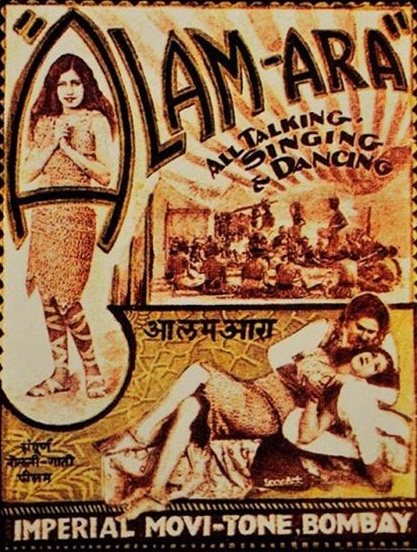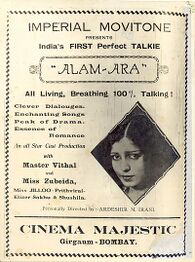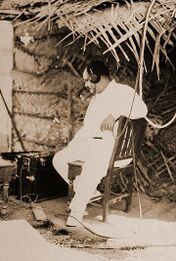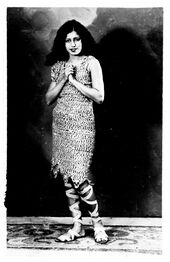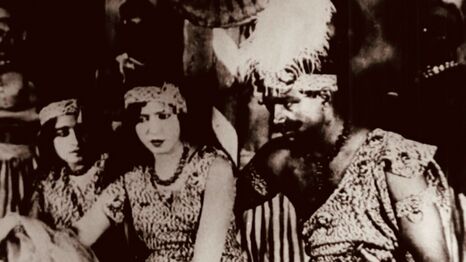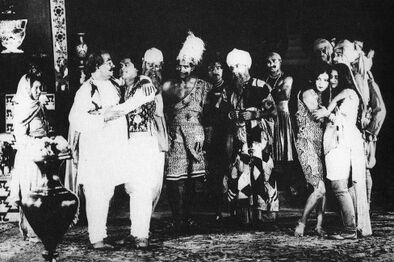Alam Ara (lost Indian talkie film; 1931): Difference between revisions
mNo edit summary |
No edit summary |
||
| (8 intermediate revisions by 4 users not shown) | |||
| Line 1: | Line 1: | ||
{{InfoboxLost | {{InfoboxLost | ||
|title=<center>Alam Ara</center> | |title=<center>Alam Ara</center> | ||
|image=Alam Ara.jpg | |image=Alam Ara.jpg | ||
|imagecaption= The | |imagecaption= The theatrical poster of the film. | ||
|status=<span style="color:red;,">'''Lost'''</span> | |status=<span style="color:red;,">'''Lost'''</span> | ||
}} | }} | ||
Alam Ara or Ornament of the World is a 1931 Indian historical fantasy film directed and produced by Ardeshir Irani. | '''''Alam Ara''''' or ''Ornament of the World'' is a 1931 Indian historical fantasy film directed and produced by Ardeshir Irani. It is the first Indian sound film and was widely acclaimed before becoming lost to the general public. | ||
== Backstory == | |||
Irani was inspired to make this film after watching the 1929 American part-talkie show “Show Boat”. Even though he didn’t | ==Backstory== | ||
== Production == | Irani was inspired to make this film after watching the 1929 American part-talkie show “Show Boat”. Even though he didn’t have experience creating any film, he was determined to make it and decided to not follow any precedential sound film. | ||
Irani produced the film for Imperial Film Company or IFC, an entertainment studio he co-founded. The story was adapted from Joseph David’s Parci Play of the same name while the screenplay was done by Irani. Zubeida was cast in the title role after Ruby Myers was unable to join the film because she couldn’t speak the film’s language, Hindustani. Irani wanted Mehboon Khan to play as the lead male before deciding to give the role to Master Vithal, who already ended his ongoing contract with Saradhi Studios and was trying to be sued. Alam Ara was funded for ₹40,000 or $130,000 in the U.S. As the film was near a train station, the film had to be shot at 1:00 to 4:00 AM to avoid noise. Irani and Rustom Bharucha, a lawyer and manager for Imperial | |||
== Soundtrack == | ==Production== | ||
Irani produced the film for Imperial Film Company or IFC, an entertainment studio he co-founded. The story was adapted from Joseph David’s Parci Play of the same name while the screenplay was done by Irani. Zubeida was cast in the title role after Ruby Myers was unable to join the film because she couldn’t speak the film’s language, Hindustani. Irani wanted Mehboon Khan to play as the lead male before deciding to give the role to Master Vithal, who already ended his ongoing contract with Saradhi Studios and was trying to be sued. Alam Ara was funded for ₹40,000 or $130,000 in the U.S. As the film was near a train station, the film had to be shot at 1:00 to 4:00 AM to avoid noise. Irani and Rustom Bharucha, a lawyer, and manager for Imperial worked as sound technicians for the film, and before shooting, they had to learn the basics of sound recording by Wilford Deming. They used “Tanar”, a single system recording in which sound is recorded at the same time of the shooting. The film was then finished and edited by Ezra Mir with its length at 10,500 ft (3,200 ft). | |||
==Soundtrack== | |||
The soundtrack of Alam Ara was released by Saregama and has a total of seven songs. | The soundtrack of Alam Ara was released by Saregama and has a total of seven songs. | ||
* De De Khuda Ke Naam Pe Pyaare | * De De Khuda Ke Naam Pe Pyaare | ||
| Line 20: | Line 22: | ||
* Bhar Bhar Ke Jaam Pila Ja | * Bhar Bhar Ke Jaam Pila Ja | ||
* Daras Bin Morey Hain Tarse Nayna Pyare | * Daras Bin Morey Hain Tarse Nayna Pyare | ||
They were all sung by Muhammad Wazir Khan and was the first song in Hindi Cinema | They were all sung by Muhammad Wazir Khan and was the first song in Hindi Cinema. | ||
== Legacy | |||
==Legacy == | |||
After the film was released, it became a huge success, Critics were generally positive to the film while some criticized the audio recording. It has been described as the rise of India films, and a turning point for Irani’s career. | After the film was released, it became a huge success, Critics were generally positive to the film while some criticized the audio recording. It has been described as the rise of India films, and a turning point for Irani’s career. | ||
The film is listed in | The film is listed in | ||
* 40 Firsts in Indian Cinema | * 40 Firsts in Indian Cinema<ref>https://www.ndtv.com/entertainment/indian-cinema-100-40-firsts-in-indian-cinema-633031/amp/1</ref> | ||
* 100 Filmfare Days | * 100 Filmfare Days<ref>https://m.filmfare.com/features/100-filmfare-days-2-alam-ara-5935.amp</ref> | ||
* 70 Iconic Films of Indian | * 70 Iconic Films of Indian Cinema<ref>https://www.livemint.com/Consumer/bQ0uThQTjybnvoYe13twlJ/70-iconic-films-of-Indian-cinema.html?facet=amp</ref> | ||
Google even made a doodle for its 80th anniversary in March 14, 2011. | |||
==Availablity== | |||
The only surviving print of ''Alam Ara'' was destroyed in a fire at National Film Archives of India in 2003, along with a copy of the first Marathi sound film ''Ayodhyecha Raja''<ref>https://indianexpress.com/article/cities/pune/we-were-lucky-that-we-could-save-ayodhyecha-raja-anil-damle/</ref>. The only availability we have is stills and posters of the movie. It’s considered completely lost and declared as India’s most important lost film. | |||
==Gallery== | |||
<gallery mode=packed heights=175px> | |||
Alam Ara Still.jpg|Vithal and Zubeida in a scene of the film. | |||
Alam Ara Promotional Poster.jpg|The promotional poster for the film | |||
Irani working for the film.jpg|An Photo of Irani working for the film | |||
Zubeida as Alam Ara.jpg|A photo of Zubeida as Alam Ara | |||
Still from the Alam Ara.jpg | |||
Another still from Alam Ara.jpg| | |||
Still from the end scene of Alam Ara.jpg|thumb|A still from the end scene, where the cast meet together | |||
</gallery> | |||
==External Links== | |||
*[https://en.m.wikipedia.org/wiki/Alam_Ara Wikipedia Article] | |||
*[https://www.bbc.com/news/world-asia-india-61404876.amp BBC Article] | |||
*[https://www.imdb.com/title/tt0021594/ IMDb page] | |||
==References== | |||
{{reflist}} | |||
[[Category:Lost films]] | [[Category:Lost films]] | ||
[[Category: | [[Category:Historic]] | ||
[[Category:Completely lost media]] | [[Category:Completely lost media]] | ||
Latest revision as of 21:25, 13 June 2024
Alam Ara or Ornament of the World is a 1931 Indian historical fantasy film directed and produced by Ardeshir Irani. It is the first Indian sound film and was widely acclaimed before becoming lost to the general public.
Backstory
Irani was inspired to make this film after watching the 1929 American part-talkie show “Show Boat”. Even though he didn’t have experience creating any film, he was determined to make it and decided to not follow any precedential sound film.
Production
Irani produced the film for Imperial Film Company or IFC, an entertainment studio he co-founded. The story was adapted from Joseph David’s Parci Play of the same name while the screenplay was done by Irani. Zubeida was cast in the title role after Ruby Myers was unable to join the film because she couldn’t speak the film’s language, Hindustani. Irani wanted Mehboon Khan to play as the lead male before deciding to give the role to Master Vithal, who already ended his ongoing contract with Saradhi Studios and was trying to be sued. Alam Ara was funded for ₹40,000 or $130,000 in the U.S. As the film was near a train station, the film had to be shot at 1:00 to 4:00 AM to avoid noise. Irani and Rustom Bharucha, a lawyer, and manager for Imperial worked as sound technicians for the film, and before shooting, they had to learn the basics of sound recording by Wilford Deming. They used “Tanar”, a single system recording in which sound is recorded at the same time of the shooting. The film was then finished and edited by Ezra Mir with its length at 10,500 ft (3,200 ft).
Soundtrack
The soundtrack of Alam Ara was released by Saregama and has a total of seven songs.
- De De Khuda Ke Naam Pe Pyaare
- Badla Dilwayega Yaar Ab Tu Sitamgaroon Se
- Rootha Hai Aasmaan
- Teri Kateelee Nigaahon Ne Mara
- De Dil Ko Aaram Aey Saaki Gulfaam
- Bhar Bhar Ke Jaam Pila Ja
- Daras Bin Morey Hain Tarse Nayna Pyare
They were all sung by Muhammad Wazir Khan and was the first song in Hindi Cinema.
Legacy
After the film was released, it became a huge success, Critics were generally positive to the film while some criticized the audio recording. It has been described as the rise of India films, and a turning point for Irani’s career. The film is listed in
Google even made a doodle for its 80th anniversary in March 14, 2011.
Availablity
The only surviving print of Alam Ara was destroyed in a fire at National Film Archives of India in 2003, along with a copy of the first Marathi sound film Ayodhyecha Raja[4]. The only availability we have is stills and posters of the movie. It’s considered completely lost and declared as India’s most important lost film.
Gallery
External Links
References
- ↑ https://www.ndtv.com/entertainment/indian-cinema-100-40-firsts-in-indian-cinema-633031/amp/1
- ↑ https://m.filmfare.com/features/100-filmfare-days-2-alam-ara-5935.amp
- ↑ https://www.livemint.com/Consumer/bQ0uThQTjybnvoYe13twlJ/70-iconic-films-of-Indian-cinema.html?facet=amp
- ↑ https://indianexpress.com/article/cities/pune/we-were-lucky-that-we-could-save-ayodhyecha-raja-anil-damle/
